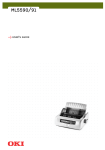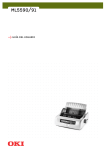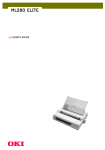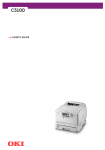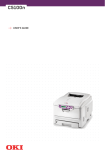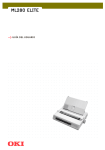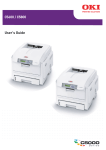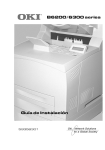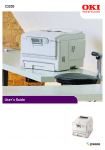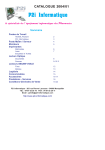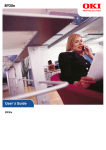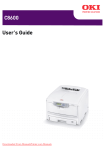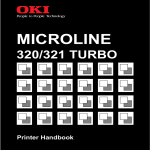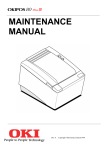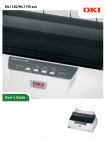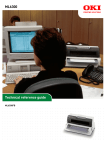Download ML5520/21 - CNET Content Solutions
Transcript
ML5520/21 user’s guide PREFACE Every effort has been made to ensure that the information in this document is complete, accurate, and up-to-date. The manufacturer assumes no responsibility for the results of errors beyond its control. The manufacturer also cannot guarantee that changes in software and equipment made by other manufacturers and referred to in this guide will not affect the applicability of the information in it. Mention of software products manufactured by other companies does not necessarily constitute endorsement by the manufacturer. While all reasonable efforts have been made to make this document as accurate and helpful as possible, we make no warranty of any kind, expressed or implied, as to the accuracy or completeness of the information contained herein. The most up-to-date drivers and manuals are available from the Oki Europe website: http://www.okieurope.com Copyright © 2003. All rights reserved. Energy Star is a trademark of the United States Environmental Protection Agency. Oki and Microline are registered trademarks of Oki Electric Industry Company, Ltd. Hewlett-Packard, HP, and LaserJet are registered trademarks of Hewlett-Packard Company. Microsoft, MS-DOS and Windows are registered trademarks of Microsoft Corporation. Other product names and brand names are registered trademarks or trademarks of their proprietors. As an Energy Star Program Participant, the manufacturer has determined that this product meets the Energy Star guidelines for energy efficiency. This product complies with the requirements of the Council Directives 89/336/EEC (EMC) and 73/23/EEC (LVD) as amended where applicable on the approximation of the laws of the member states relating to electromagnetic compatibility and low voltage. PREFACE > 2 CONTENTS Preface . . . . . . . . . . . . . . . . . . . . . . . . . . . . . . . . . . . . . . . . . . . . . 2 Introduction . . . . . . . . . . . . . . . . . . . . . . . . . . . . . . . . . . . . . . . . . 6 Features / Tips . . . . . . . . . . . . . . . . . . . . . . . . . . . . . . . . . . . . 6 Printer Drivers. . . . . . . . . . . . . . . . . . . . . . . . . . . . . . . . . . . . . . . . 9 Emulations . . . . . . . . . . . . . . . . . . . . . . . . . . . . . . . . . . . . . . . 9 Printer Drivers . . . . . . . . . . . . . . . . . . . . . . . . . . . . . . . . . . . . . 9 Installing the driver. . . . . . . . . . . . . . . . . . . . . . . . . . . . . . 9 Using a Compatible Driver . . . . . . . . . . . . . . . . . . . . . . . 10 Interfaces - General. . . . . . . . . . . . . . . . . . . . . . . . . . . . . 10 Connecting the USB Cable . . . . . . . . . . . . . . . . . . . . . . . 11 Using your printer . . . . . . . . . . . . . . . . . . . . . . . . . . . . . . . . . . . 13 Components: Rear Feed (Continuous Forms) . . . . . . . . . . . 13 Components: Top Feed (Single Sheets) . . . . . . . . . . . . . . . 13 Top of Form (TOF) . . . . . . . . . . . . . . . . . . . . . . . . . . . . . . . . . 14 Forms Tear-Off . . . . . . . . . . . . . . . . . . . . . . . . . . . . . . . . . . . 15 Setting Top of Form (TOF) . . . . . . . . . . . . . . . . . . . . . . . . . . . 16 Temporarily Changing the Top of Form . . . . . . . . . . . . . . . . 18 Resetting Top of Form to the Factory Default . . . . . . . . . . . 18 Forms Tear-Off Feature . . . . . . . . . . . . . . . . . . . . . . . . . . . . . 18 Potential issues with software packages . . . . . . . . . . . 19 Changing the Forms Tear-Off Setting . . . . . . . . . . . . . . . . . 20 Manual Forms Tear-Off . . . . . . . . . . . . . . . . . . . . . . . . . . . . . 20 Paper Park. . . . . . . . . . . . . . . . . . . . . . . . . . . . . . . . . . . . . . . 21 Changing Paper Paths . . . . . . . . . . . . . . . . . . . . . . . . . . . . . 21 Continuous Forms to Single Sheets. . . . . . . . . . . . . . . . 21 Single Sheets to Continuous Forms. . . . . . . . . . . . . . . . 22 Printhead Gap . . . . . . . . . . . . . . . . . . . . . . . . . . . . . . . . . . . . 24 Print Quality . . . . . . . . . . . . . . . . . . . . . . . . . . . . . . . . . . . . . 25 Character Pitch . . . . . . . . . . . . . . . . . . . . . . . . . . . . . . . . . . . 26 Epson and IBM Emulations. . . . . . . . . . . . . . . . . . . . . . . 26 Printer Reset . . . . . . . . . . . . . . . . . . . . . . . . . . . . . . . . . . . . . 27 Emulations. . . . . . . . . . . . . . . . . . . . . . . . . . . . . . . . . . . . 27 Menu Mode. . . . . . . . . . . . . . . . . . . . . . . . . . . . . . . . . . . . . . . . . 28 Menu Mode Keys . . . . . . . . . . . . . . . . . . . . . . . . . . . . . . . . . 28 Entering and Exiting Menu Mode . . . . . . . . . . . . . . . . . . 29 Resetting the Menu to the Factory Defaults . . . . . . . . . 29 CONTENTS > 3 Printing the Menu Settings. . . . . . . . . . . . . . . . . . . . . . . 29 Printing all Menu Settings . . . . . . . . . . . . . . . . . . . . . . . 29 Changing the Menu Settings . . . . . . . . . . . . . . . . . . . . . 29 Menu Settings. . . . . . . . . . . . . . . . . . . . . . . . . . . . . . . . . . . . 30 Explanation of Menu Items. . . . . . . . . . . . . . . . . . . . . . . 34 Maintenance. . . . . . . . . . . . . . . . . . . . . . . . . . . . . . . . . . . . . . . . 42 Replacing the Ribbon Cartridge. . . . . . . . . . . . . . . . . . . . . . 42 Loading Paper . . . . . . . . . . . . . . . . . . . . . . . . . . . . . . . . . . . . 44 Rear Feed . . . . . . . . . . . . . . . . . . . . . . . . . . . . . . . . . . . . . 44 Top Feed (Single Sheets) . . . . . . . . . . . . . . . . . . . . . . . . 54 Clearing Paper Jams . . . . . . . . . . . . . . . . . . . . . . . . . . . . . . . 55 Rear Feed Jams . . . . . . . . . . . . . . . . . . . . . . . . . . . . . . . . 55 Rear Feed, Repeating Paper Jams . . . . . . . . . . . . . . . . . 57 Single Sheet Paper Jams . . . . . . . . . . . . . . . . . . . . . . . . 60 Cleaning the Housing . . . . . . . . . . . . . . . . . . . . . . . . . . . . . . 61 Troubleshooting . . . . . . . . . . . . . . . . . . . . . . . . . . . . . . . . . . . . . 63 General Information . . . . . . . . . . . . . . . . . . . . . . . . . . . . . . . 63 Parts and Accessories . . . . . . . . . . . . . . . . . . . . . . . . . . . . . . . . 68 Printer Control Codes. . . . . . . . . . . . . . . . . . . . . . . . . . . . . . . . . 70 IBM Proprinter III Commands. . . . . . . . . . . . . . . . . . . . . . . . 70 Epson FX Commands . . . . . . . . . . . . . . . . . . . . . . . . . . . . . . 72 Oki Microline Standard Commands . . . . . . . . . . . . . . . . . . 74 Specifications. . . . . . . . . . . . . . . . . . . . . . . . . . . . . . . . . . . . . . . 76 Setting up your Printer. . . . . . . . . . . . . . . . . . . . . . . . . . . . . . . . 80 Location. . . . . . . . . . . . . . . . . . . . . . . . . . . . . . . . . . . . . . . . . 80 Unpacking . . . . . . . . . . . . . . . . . . . . . . . . . . . . . . . . . . . . . . . 80 Installing the Ribbon Cartridge . . . . . . . . . . . . . . . . . . . . . . 83 Ribbon Cartridge Handling . . . . . . . . . . . . . . . . . . . . . . . 83 Power Connection. . . . . . . . . . . . . . . . . . . . . . . . . . . . . . . . . 85 Computer Connections. . . . . . . . . . . . . . . . . . . . . . . . . . . . . 86 Parallel (LPT), IEEE 1284 . . . . . . . . . . . . . . . . . . . . . . . . . 86 USB, Specification 1.1 Compliant . . . . . . . . . . . . . . . . . 86 Loading Paper . . . . . . . . . . . . . . . . . . . . . . . . . . . . . . . . . 87 Testing the Printer. . . . . . . . . . . . . . . . . . . . . . . . . . . . . . 87 Index . . . . . . . . . . . . . . . . . . . . . . . . . . . . . . . . . . . . . . . . . . . . . . 91 Oki contact details . . . . . . . . . . . . . . . . . . . . . . . . . . . . . . . . . . . 94 CONTENTS > 4 NOTES, CAUTIONS AND WARNINGS NOTE A note appears in this manual like this. A note provides additional information to supplement the main text which may help you to use and understand the product. CAUTION! A caution appears in this manual like this. A caution provides additional information which, if ignored, may result in equipment malfunction or damage. WARNING! A warning appears in this manual like this. A warning provides additional information which, if ignored, may result in a risk of personal injury. NOTES, CAUTIONS AND WARNINGS > 5 INTRODUCTION > Extremely reliable, durable operation: 20,000 hours Mean Time Between Failures (MTBF) at 25% duty cycle and 35% page density. > Advanced paper handling, with built-in rear push tractor and zero-tear forms capability. > Very high print speeds: > > High Speed Draft (HSD) Mode: 507 cps > Utility Mode: 380 cps > Near Letter Quality (NLQ) Mode: 95 cps > Super Speed Draft (SSD) Mode: 570 cps This rugged 9-pin printer can meet the needs of harsh and demanding environments. FEATURES / TIPS Forms Tear-Off The Forms Tear-Off feature allows a printed continuous forms page to be torn off without wasting paper or adjusting the printer. When printing stops, Forms Tear-Off automatically moves the paper to align the perforation with the tear bar (located under the access cover), after a time interval which you select through the menu. Paper remains in the tear-off position until the printer receives more data. Then, the paper moves back down for printing. This feature has to be enabled. Paper Park Your printer’s paper park feature allows you to print a single sheet (cut-sheet) page without removing continuous feed paper from the printer. For more information, see “Paper Park” in “Using your Printer”. INTRODUCTION > 6 Top of Form (TOF) Top of Form (TOF) sets the print start position. The factory default is 1" from the top. The TOF can be changed in increments of 1/144", for a single print job or set to a new default. The overall amount of adjustment is limited to avoid paper jams. The first line prints at the red line of the plastic paper shield (1) on the printhead. 1 For more information, see “Top of Form (TOF)” in “Using your Printer”. NOTE The Forms Tear-Off and the Top of Form settings interact. For more information, see “Top of Form (TOF) and Forms Tear-Off” in “Using your Printer”. Turning the Platen Knob Always turn the printer off before turning the platen knob! If you turn the platen knob when the printer is on, the Top of Form will misalign. INTRODUCTION > 7 Controlling Access to the Printer > You can control access to the printer by changing the setting for the Operator Panel Function in the Menu from Full Operation (the factory default) to Limited Operation. > When Limited Operation is selected, the PRINT QUALITY and CHARACTER PITCH keys don’t work. This prevents these settings from being changed from the control panel when several people are using the printer. For more information, see “Changing the Menu Settings” in “Using your Printer”. INTRODUCTION > 8 PRINTER DRIVERS EMULATIONS The factory default emulation for your printer is IBM PPR. If you wish to change to one of the Epson or Microline emulations, see “Using your Printer”. PRINTER DRIVERS The Oki driver for your printer is provided on the CD included with the printer. You can either load the Oki driver or select one of the compatible drivers listed below in your software application. 1. Insert the CD into your CD-ROM drive. NOTE If the CD does not AutoPlay, click Start → Run → Browse, then browse to your CD-ROM drive, double-click Install.exe and click OK. 2. Select your Language. 3. When the Menu Installer window appears, click the Driver Installation button. 4. Follow the on-screen instructions. INSTALLING THE DRIVER NOTE Installation of the Oki USB driver is only required for Windows 98. You may be called upon for your original Windows 98 CD. Please have this available. 1. When the [Add Printer] window appears, click [Next]. 2. Select the directory on the CD where the drivers are located. on the Oki CD they are situated in: X:\Drivers\WinVer\CodePage where X: is CD drive letter; PRINTER DRIVERS > 9 WinVer is the Windows versions, and CodePage is the selected option. NOTE To find out more about Code pages, see Help on the Oki CD Browser. 3. After files have finished copying, click [Finish]. 4. Switch your printer ON. USING A COMPATIBLE DRIVER The drivers below are listed by decreasing compatibility with your printer. Use one as close to the top of the list as possible. IBM Proprinter III l IBM Proprinter III — factory setting l IBM Proprinter II l IBM Proprinter Epson FX l Epson FX 286e l Epson FX 850/1050 l Epson FX 800/1000 INTERFACES - GENERAL Your printer is equipped with a selection of data interfaces: Under no circumstances attempt to use both parallel and USB ports simultaneously. 1. Parallel – For direct connection to a PC. This port requires a bi-directional (IEEE 1284 compliant) parallel cable. 2. USB – For connection to a PC running Windows 98 or above (not Windows 95 upgraded to Windows 98) or Macintosh. Windows NT 4.0 does not support USB. Administrator PRINTER DRIVERS > 10 privileges are necessary for Windows 2000 and Windows XP installations. This port requires a cable conforming to USB version 1.1 or above. A genuine cable displays the Trident symbol on both connectors. Using an inferior cable can cause printing problems and special cables are needed for longer runs than five metres. The operation of a printer is not assured if a USB compatible device is connected concurrently with other USB compatible machines. When connecting multiple printers of the same type, they appear as *****, ***** (2), ***** (3), etc. These numbers depend on the order of connecting or turning on each printer. CONNECTING THE USB CABLE Due to the number of possible variants of operating systems it is not possible to describe every combination. Terminology may vary between Windows operating systems and some knowledge is assumed. If you are unsure how to proceed, you should consult your computer documentation or system manager for details. This example uses Windows 2000 Professional. 1. Ensure the printer and computer are easily accessible and turn both units off. This is not strictly necessary but may prevent any problems being caused by the accidental dislodging of power or other cables. 2. Plug the Series A male connector (a) into the the computer’s USB port or into a suitable USB hub. 3. Plug the Series B Male connector (b) into the printer’s USB port. 4. Switch on both the computer and printer. PRINTER DRIVERS > 11 b a 5. The printer will be identified immediately by the New Hardware Wizard and install itself in the Printer folder. An additional item, USB Printing Support will also appear in the Device Manager each time the printer is switched ON and connected. 6. Check that the default paper size has been correctly set by looking at the settings in the Settings > Printers folder. Under the printer's Properties > General tab, the current paper selection is shown. The printer picks up its initial setting from the Locale settings on the host computer. The paper size can be altered by using the drop down arrow and selecting an alternative size. 7. If the printer had formerly been used as a parallel or serial device and there is no output from the printer once a USB cable has been connected, check to see that the correct port has been selected. This information can also be found in the Properties folder but under the Ports tab. Amend as necessary. 8. If there are printing problems, check to see whether there is a USB connection active in the Control Panel. If there is no USB connection shown, you must install the hub. 9. Alternatively, there may be a problem if the printer is connected via a USB hub. Disconnect the printer cable from the hub and connect it directly to the computer. PRINTER DRIVERS > 12 USING YOUR PRINTER COMPONENTS: REAR FEED (CONTINUOUS FORMS) The serial number of your printer is on a label fixed to the back of the printer. 1 7 6 2 3 5 1. 2. 3. 4. 4 Sheet Guide Paper Lever ON-OFF Switch Platen Knob 5. Control Panel 6. Acoustic Cover 7. Access Cover COMPONENTS: TOP FEED (SINGLE SHEETS) 1 2 7 3 4 5 6 1. 2. 3. 4. Paper Guides Sheet Guide Paper Lever ON-OFF Switch 5. Platen Knob 6. Control Panel 7. Acoustic Cover USING YOUR PRINTER > 13 NOTE For single-sheet printing, the paper lever must be in the middle position. TOP OF FORM (TOF) Top of Form (TOF) sets the print start position. The factory default is 1" from the top. The TOF can be changed in increments of 1/144", for either a single print job, or all print jobs. The overall amount of adjustment is limited to avoid paper jams. The first line prints at the red line of the plastic paper shield (1) on the printhead. 1 CAUTION! If you turn the platen knob when the printer is not at Top of Form, the TOF will misalign. Always feed the paper to TOF before turning the platen knob. NOTE > Your software may print the first line of print above or below where TOF is set. You may need to adjust the TOF to meet your software’s requirements. > The Top of Form and Forms Tear-Off settings of your printer interact. How you set the Top of Form depends on whether Forms Tear-Off is ON (set to 500 ms, 1 sec, or 2 sec) or OFF (the factory default setting). USING YOUR PRINTER > 14 FORMS TEAR-OFF There are two ways to determine the status of the Forms Tear-Off menu setting: l Print the Menu. l Use the TEAR key. To print the Menu: 2 1 3 4 1. Make sure paper is loaded. 2. Hold SHIFT (2), then press SEL (1) to enter the Menu Mode. 3. Press PARK (4) to print the menu. 4. Look for the Form Tear-Off setting in the paper feed group you are using (Rear Feed, Bottom Feed or Top Feed—Forms Tear– Off appears in the Top Feed group only if the optional Roll Paper Stand is installed). To use the TEAR key: 1. Make sure paper is loaded and wait 2 seconds. 2. Press TEAR (3). l If the paper moves up, Forms Tear-Off is OFF. l If the paper moves down, Forms Tear-Off is ON. USING YOUR PRINTER > 15 SETTING TOP OF FORM (TOF) CAUTION! Do not use the platen knob to change the Top of Form. If you turn the platen knob when the printer is not at Top of Form, the TOF will misalign. Always feed the paper to TOF before turning the platen knob. The first line prints at the red line of the plastic paper shield on the printhead. Forms Tear-Off set to OFF - (default) With paper loaded and the printer ON: 1 2 3 4 5 6 1. Press PARK (6) to park the paper. 2. Press FF/LOAD (4) to load the paper. 3. If the printer is ON line, press SEL | MENU (1) to take the printer OFF line. The SEL light goes out. 4. Press and hold SHIFT (2), then: 7 l Press LF | Micro Feed Down (3) to set the TOF higher (the paper moves down). l Press FF/LOAD | Micro Feed Up (4) to set the TOF lower (the paper moves up). (When you begin pressing the Micro Feed key, the printhead will move to the right). 5. Press SEL | MENU (1) to place the printer back on line. To reset the Top of Form to the factory default, see “Resetting Top of Form to the Factory Default” later in this chapter. USING YOUR PRINTER > 16 Forms Tear-Off set to ON With paper loaded and the printer ON and selected: 1 2 3 4 5 6 7 1. Press PARK (6) to park the paper. The SEL light goes off and the red alarm light comes on. 2. Press FF | LOAD (4) to load the paper. 3. Wait briefly until the paper moves up to the tear position, then press and hold TEAR (5). The paper moves to the current TOF and the SEL light is illuminated. 4. If the printer is ON line, press SEL | MENU (1) to take the printer OFF line. The SEL light goes out. 5. Hold down SHIFT (2), then: l Press LF | Micro Feed Down (3) to set the TOF higher (the paper moves down). l Press FF/LOAD | Micro Feed Up (4) to set the TOF lower (the paper moves up). (When you begin pressing the Micro Feed key, the printhead will move to the right). 6. Press SEL | MENU (1) to save the setting and place the printer back on line. To reset the Top of Form to the factory default, see the next page. USING YOUR PRINTER > 17 TEMPORARILY CHANGING THE TOP OF FORM CAUTION! Do not use the platen knob to change the Top of Form. If you turn the platen knob when the printer is not at Top of Form, the TOF will misalign. Always feed the paper to TOF before turning the platen knob! To move the Top of Form position lower for one page only: 1. Press SEL to deselect the printer. 2. Press LF to lower the position of the Top of Form. RESETTING TOP OF FORM TO THE FACTORY DEFAULT The factory default setting for the Top of Form (where the printing should begin) is 1" down from the top of the page. To reset the Top of Form to the factory default: 1. Remove paper from the paper path. 2. Turn the printer off. 3. Press and hold PARK + QUIET | TOF while turning on the printer. 4. Reload paper. FORMS TEAR-OFF FEATURE This feature is normally turned off. To use Forms Tear-Off, you must enter the menu and change the setting to the desired time interval (see “Changing the Forms Tear- Off Settings”). The Forms Tear-Off feature allows a printed continuous forms page to be torn off without wasting paper or adjusting the printer. It can be used for rear feed continuous forms, bottom feed continuous forms (with the optional push tractor installed), or for top feed roll paper (with optional roll paper stand installed). When the printer is turned on, the paper feeds to the tear-off position. USING YOUR PRINTER > 18 When data is received, the paper automatically moves down to the print position (TOF) and printing begins. NOTE You can also move the paper down to the print position manually by pressing TEAR. When printing stops, Forms Tear-Off automatically moves the paper to align the perforation with the tear bar (located under the access cover), after the time interval which you selected through the menu. Paper remains in the tear-off position until the printer receives more data. Then, the paper moves back down for printing. NOTE > The status of the Forms Tear-Off menu setting affects how you set the Top of Form: see “Top of Form (TOF) and Forms Tear-Off” earlier in this chapter. > Do not use Forms Tear-Off with labels or multipart forms! > Forms Tear-Off cannot be used when the optional pull tractor is engaged. POTENTIAL ISSUES WITH SOFTWARE PACKAGES If Forms Tear-Off is set to ON and the software package you are using “pauses” for a long enough interval while sending data to the printer, Forms Tear-Off may be activated. No data is lost, but this causes uneven print registration due to the paper movement. If this occurs, use the menu to turn off this feature, then use the TEAR key to move the paper up to the tear position manually (see “Changing the Forms Tear-off Settings”). USING YOUR PRINTER > 19 CHANGING THE FORMS TEAR-OFF SETTING The default setting for Forms Tear-Off is OFF. 1 2 3 4 5 7 6 To change the Forms Tear-Off setting: 1. Press SHIFT (2) + SEL (1). 2. Press GROUP (3) repeatedly until the Rear Feed or Bottom Feed group shows in the first column of the printed line, depending on which paper feed you are using, 3. Press ITEM (4) repeatedly until Form Tear-Off appears in the second column: Rear Feed 4. Off Press SET (5) until the time interval you wish to select appears in the third column: Rear Feed 5. Form Tear-Off Form Tear-Off 1 Sec Press SHIFT (2) + SEL (1) to exit Menu Mode and save the setting. MANUAL FORMS TEAR-OFF If you don’t wish to engage the Forms Tear-Off feature, you can advance: l rear-feed continuous forms loaded on the built-in tractor or l bottom-feed continuous forms loaded on the optional push tractor up to the tear-off position manually by pressing TEAR (5). USING YOUR PRINTER > 20 PAPER PARK CAUTION! Never park labels. Paper park allows you to switch to single-sheet printing without removing continuous feed paper from the printer. When you wish to print single sheets, simply press PARK (6) to retract the continuous form paper from the paper path, then lift the sheet guide, load the sheet and send the print job. CHANGING PAPER PATHS CONTINUOUS FORMS TO SINGLE SHEETS 1. Tear off any printed pages, then press PARK. 2. Raise the sheet guide (1) to the single-sheet feed position. 1 3. Pivot the wire feed guide into the sheet guide. USING YOUR PRINTER > 21 4. Move the paper lever (1) to the middle position marked “TOP.” 1 5. Adjust the paper guides (1) for the size of paper you are using, then place a sheet of paper in the sheet guide. 1 SINGLE SHEETS TO CONTINUOUS FORMS 1. Press FF/LOAD to remove the single-sheet paper. 2. Lower the sheet guide into the continuous-forms position. USING YOUR PRINTER > 22 3. Swing the wire feed guide over onto the pull-up roller. 4. Move the paper lever to the appropriate position. 5. l Rear feed: l Bottom feed: l If necessary, load continuous-form paper. Press FF/LOAD. USING YOUR PRINTER > 23 PRINTHEAD GAP 1. The printhead gap is the distance between the printhead and the platen. CAUTION! Make sure the printer is turned off before you open the access cover. To adjust the gap, open the access cover and move the coloured lever (1) to the recommended setting from the table. 1 Setting 1 2 3 4 5 Media Standard paper 2-part form (with carbon) 3-part form (with carbon) 4-part form (with carbon) Envelopes or extra thick paper NOTE When the head gap is set to 2, 3, 4 or 5, the printer automatically slows down for better print quality with multipart forms. USING YOUR PRINTER > 24 PRINT QUALITY 1 Press PRINT QUALITY (1) to select: Utility (UTL)—the default: l Medium quality, medium speed (380 cps) Gothic typeface only High Speed Draft (HSD): l Lower quality, higher speed (507 cps) Gothic typeface only Super Speed Draft (SSD): l Lowest quality, highest speed (570 cps) Gothic typeface only Near Letter Quality (NLQ): l Highest quality, slowest speed (95 cps) Courier or Gothic NOTE Front panel settings for print quality and character pitch are normally overridden by software commands. USING YOUR PRINTER > 25 CHARACTER PITCH 1 Character pitch determines how many characters will print on each line. You can choose a specific fixed width for each character in characters per inch (cpi), or Proportional. The higher cpi settings are often used for spreadsheets. Proportional (PROP) sets character widths based on the character itself: e.g., the letter i is assigned a narrower width than the letter m. This provides a more polished, typeset appearance. NOTE Front panel settings for character pitch are normally overridden when the SI command is received from your software. EPSON AND IBM EMULATIONS Set the character pitch by pressing CHARACTER PITCH (1) until the light beneath the desired setting is illuminated: l 10 cpi; 12 cpi; 15 cpi; 17 cpi; 20 cpi or Proportional MICROLINE Emulation In the MICROLINE emulation, the Character Pitch choices are: l 10 cpi; 12 cpi; 15 cpi; 17 cpi; 20 cpi, Proportional or nonproportional To select Proportional, press the CHARACTER PITCH key until both the cpi value and PROP lights are illuminated. To select non-proportional, press the CHARACTER PITCH key until the light for the cpi value you wish to use is illuminated. USING YOUR PRINTER > 26 PRINTER RESET 1 2 4 3 5 Clearing some error conditions requires that you reset (reinitialise) the printer. To do this: 1. Press and release SEL (1) to take the printer off-line. The SEL light goes out. 2. Press and hold SHIFT (2), then press the RESET/CHARACTER PITCH key (5). NOTE Pressing SHIFT and RESET reinitialises the printer, but does not affect any menu settings and does not reset the printer to the factory defaults. For information on resetting the printer to the factory defaults, see “Resetting the Menu to the Factory Defaults” later in this chapter. EMULATIONS l IBM® Proprinter III — factory setting l Epson® FX l Oki® MICROLINE® Changing Emulations Make sure paper is loaded. 1. Press and hold SHIFT (2), then press SEL (1). 2. Press LF (3). The following line will print: Printer Control Emulation Mode IBM PPR 3. Press TEAR (4) repeatedly until the emulation you wish to select prints in the right-hand column. 4. Press and hold SHIFT (2), then press SEL (1) to save your setting and exit the Menu Mode. USING YOUR PRINTER > 27 MENU MODE In Menu Mode, use the front panel keys to change the defaults for the printer parameters. The changes made in the Menu Mode are automatically saved when you exit the Menu Mode and are retained, even when the printer is turned off. NOTE Please print the current Menu Mode settings before you reset or change them. This is the only way to have a record of the settings. MENU MODE KEYS 1 2 5 3 4 GROUP Key Prints the next Group in the Menu. With the SHIFT key, prints the previous Group. ITEM Key Prints the next Item in the Group. With the SHIFT key, prints the previous Item in the Group. SET Key Prints the next setting for an Item. With the SHIFT key, prints the previous setting for an Item. PRINT Key Prints a copy of all the Menu settings. With the SHIFT key, prints the current settings for the Group selected. MENU Light ON when the printer is in the Menu Mode. MENU MODE > 28 ENTERING AND EXITING MENU MODE Hold down the SHIFT key while pressing SEL. RESETTING THE MENU TO THE FACTORY DEFAULTS 1. Turn the printer off. 2. Press SEL and LF while turning the printer ON. PRINTING THE MENU SETTINGS 1. Make sure paper is loaded in the printer. 2. Press and hold SHIFT, then press SEL to enter the Menu Mode. 3. Press PRINT (PARK key). PRINTING ALL MENU SETTINGS To print out a listing of the settings for all menu items, regardless of the emulation selected or the accessories installed: Make sure paper is loaded in the printer. 1. Press and hold SHIFT, then press SEL to enter the Menu Mode. 2. Press and hold SHIFT, then press PRINT QUALITY. CHANGING THE MENU SETTINGS 1. Press and hold SHIFT, then press SEL to enter the Menu Mode. 2. Use the GROUP, ITEM and SET keys to make your changes: 3. Press GROUP until the Group you wish to change appears in the first column. 4. Press ITEM until the Item you wish to change appears in the second column. 5. Press SET until the setting you want appears in the third column. MENU MODE > 29 6. Press and hold SHIFT, then press SEL to exit the Menu Mode and save your settings. NOTE If you turn off the printer without first exiting the Menu Mode, the changes you have made will be lost. MENU SETTINGS For a complete explanation of each menu item, see “Explanations of Menu Items” later in this chapter. The table following shows the items which may appear in the menu. Settings which are engaged at the factory (defaults) are set in bold italic. Some groups or entries will only appear when a specific emulation is engaged, as noted. Group Item Settings Printer Control Font Emulation Mode IBM PPR, Epson FX, ML Print Mode NLQ Courier, NLQ Gothic, NLQ OCR-B, Utility, HSD DRAFT Mode Pitch Proportional Spacing Style Size HSD, SSD 10 cpi, 12 cpi, 15 cpi, 17.1 cpi, 20 cpi NO, YES Normal, Italics Single, Double MENU MODE > 30 Group Item Settings Symbol Sets Character Set Set I, Set II [Epson and IBM mode] Standard, Line Graphics, Block Graphics [ML Mode] ASCII, French, German, British, Danish I, Swedish, Italian, Spanish I, Japanese, Norwegian, Danish II, Spanish II, Latin American, French Canadian, Dutch, TRS80, Swedish II, Swedish III, Swedish IV, Turkish, Swiss I, Swiss II, Publisher Slashed, Unslashed USA, Canada French, Multilingual, Portugal, Norway, Turkey, Greek_437, Greek_869, Greek_928, Greek_437 CYPRUS, Polska Mazovia, Serbo Croatic I, Serbo Croatic II, ECMA-94, Hungarian CWI, Windows Greek, Windows East Europe Windows Cyrillic, East Europe Latin II - 852, Cyrillic I - 855, Cyrillic II - 866, Kamenicky (MJK), ISO Latin 2, Turkey_857, Windows Turkey, Ukrainian, Bulgarian, ISO Latin 6 (8859/10), Windows Baltic, Baltic_774, KBL-Lithuanian, Cyrillic Latvian, Roman-8, Icelandic-861, Multilingual 858, ISO 8859-15 Greek_737 6 LPI, 8 LPI Off, 500 ms, 1 sec, 2 sec No, Yes 13.6", 8" 11", 11-2/3", 12", 14", 17", 5", 3", 3.5", 4", 5.5", 6", 7", 8", 8.5" 6LPI, 8 LPI Off, 500 ms, 1 sec, 2 sec No, Yes 13.6", 8" 11", 11-2/3", 12", 14", 17", 5", 3", 3.25", 3.5", 4", 5.5", 6", 7", 8", 8.5 Language Set Zero Character Code Page Rear Feed Line Spacing Form Tear-Off Skip Over Perforation Page Width (wide model) Page Length Bottom Feed Line Spacing Form Tear-Off Skip Over Perforation Page Width (wide model) Page Length MENU MODE > 31 Group Item Settings Top Feed Line Spacing Form Tear-Off* Bottom Margin Page Width (wide model) Page Length 6 LPI, 8 LPI Off, 500 ms, 1 sec, 2 sec Valid, Invalid 8", 13.6" 11", 11-2/3", 12", 14", 17", 5", 3", 3.25", 3.5", 4", 5.5", 6", 7", 8", 8.5" 500 ms, 1 sec, 2 sec by Actual Page Length, by MENU Setting Wait Time Page Length Control * With RollPaper Stand fitted Set-Up Graphics 7 or 8 Bit Graphics* Receive Buffer Size Paper Out Override Print Registration 1 Print Registration 2 7 or 8 Bits Data Word* Operator Panel Function Reset Inhibit Print Suppress Effective Auto LF Auto CR** CSF Bin Select*** Print DEL Code* SI Select Pitch (10 cpi)** SI Select Pitch (12 cpi)** Time Out Print Auto Select Centring Position CSF Type*** ESC SI Pitch Select Language Set Power Saving Power Save Time * When MICROLINE emulation selected. ** When IBM emulation selected. *** When Cut Sheet Feeder fitted. MENU MODE > 32 Bi-directional, Uni-directional 8, 7 1 Line, 32K, 64K, 128K No, Yes 0, range to 0.25 mm to the right or left, set in 0.05 mm increments Press SEL to shift registration to the left;press SHIFT + SEL to shift registration to the right. 0, range to 0.25 mm to the right or left, set in 0.05 mm increments press SEL to shift registration to the left; press SHIFT + SEL to shift registration to the right. 8, 7 Full Operation, Limited Operation No, Yes No, Yes No, Yes No, Yes Bin 1, Bin 2 No, Yes 15 cpi, 17.1 cpi 12 cpi, 20 cpi Valid, Invalid No, Yes DEFAULT, MODE 1, MODE 2 Wide, Narrow 17.1 cpi, 20 cpi Combined, Code Page Only Enable, Disable 5 min., 10 min., 15 min., 30 min., 60 min. Group Item Settings Parallel I/F I-Prime Pin 18 Auto Feed XT* Bi-Direction Note: Buffer Print, Buffer Clear, Invalid +5V, Open Invalid, Valid Enable, Disable *When Epson emulation selected. Serial I/F* None, Odd, Even 8 Bits, 7 Bits Ready/Busy, X/ON / X/OFF No, Yes SSD-, SSD+, DTR, RTS 19200 bps, 9600 bps, 4800 bps, 2400, 1200, 600, 300 bps Valid, Invalid Ready On Power Up, Ready On Select 200 ms, 1 sec. Parity Serial Data 7/8 bits Protocol Diagnostic Test Busy Line Baud Rate DSR Signal DTR Signal Busy Time * When Serial I/F installed. CSF Bin 1** Line Spacing Bottom Margin Page Width (Wide model) Page Length CSF Bin 2** Line Spacing Bottom MarginV Page Length * * When Cut Sheet Feeder installed. MENU MODE > 33 6 LPI, 8 LPI Valid, Invalid 8", 13.6" 11", 11-2/3", 12", 14", 17", 5", 3.5", 4", 5.5", 6", 7", 8", 8.5" 6 LPI, 8 LPI Valid, Invalid 11", 11-2/3", 12", 14", 17", 5", 3.5", 4", 5.5", 6", 7", 8", 8.5" EXPLANATION OF MENU ITEMS These explanations are in alphabetical sequence to make it easier to look them up. Some items only appear when optional accessories are installed; others appear in several groups in the menu. 7 or 8 Bit Graphics, Default = 7 Change this setting to 8 if your system uses 8-bit graphics. 7 or 8 Bit Data Word, Default = 8 Change this setting to 7 if your system uses 7-bit data word lengths. Auto CR, Default =No IBM emulation only. If you want the printer to automatically add a carriage return when a Line Feed is received at the end of a line, change the setting to Yes. Auto LF, Default = No If your printout is consistently double spaced, select No; if it overprints, select Yes. Auto Feed XT, Default = Invalid Epson emulation only. In the Epson emulation, the XT signal on pin 14 of the parallel interface can control automatic line feed. Some interface cables are wired in such a way that automatic line feed is always in effect: this item eliminates this potential problem. If your system uses pin 14 of the parallel interface to control automatic line feed, change the setting to Valid. Auto Select, Default = No Determines whether or not your printer will automatically be selected after you load in paper. With the factory default engaged, the printer will be deselected so that you can set the Top of Form. If you always use the same Top of Form position, change the setting to Yes. MENU MODE > 34 Baud Rate, Default = 9600 bps Appears only if optional Serial Interface is installed. Set this to match your system’s transmission speed. Bi-direction, Default = Enable Change this setting if you wish to disable bi-directional transmission (PnP) in Nibble mode. Bottom Margin, Default = Valid Change to Invalid if you want the printer to ignore the bottom margin setting. CAUTION! Setting the Bottom Margin to Invalid can cause loss of data and damage the printhead by allowing printing without paper. Busy Line, Default = SSDAppears only when the optional Serial Interface is installed. If Ready/ Busy protocol (factory default) is selected, you can choose which line your system monitors for a busy signal: l SSD -9V, select SSD- l SSD +9V, select SSD+ l DTR -9V, select DTR l RTS -9V, select RTS Busy Time, Default = 200 ms Appears only when the optional Serial Interface is installed. Sets the length of the busy signal when the Ready/Busy protocol (factory default) is engaged. Centering Position, Default = DEFAULT Used to limit printhead travel when printing narrow columns. l Select Mode 1 for the narrow carriage printer. l Select Mode 1 or Mode 2 for the wide carriage printer. MENU MODE > 35 Character Set, Default = IBM Set II Epson and IBM emulations only. Use this to switch character sets to IBM Set II. Character Set, Default = Standard MICROLINE emulation only. Use this to switch the character set to Line Graphics. Code Page, Default = USA Choose the Code Page character set you wish to use: USA, Canada French, Multilingual, Portugal, Norway, Turkey, Greek_437, Greek_869, Greek_928, Greek_437 CYPRUS, Polska Mazovia, Serbo Croatic I, Serbo Croatic II, ECMA-94, Hungarian CWI, Windows Greek, Windows East Europe, Windows Cyrillic, East Europe Latin II - 852, Cyrillic I - 855, Cyrillic II - 866, Kamenicky (MJK), ISO Latin 2, Turkey_857, Windows Turkey, Ukrainian, Bulgarian, ISO Latin 6 (8859/10), Windows Baltic, Baltic_774, KBL-Lithuanian, Cyrillic Latvian, Roman-8, Icelandic-861, Multilingual 858, ISO 8859-15 Greek_737. CSF Bin Select, Default = Bin 1 Appears only when the optional Dual-Bin Cut Sheet Feeder is installed. Use this to switch to Bin 2 as the default. CSF Type, Default = Wide To avoid paper jams, change this setting to Narrow if you are using the optional Cut Sheet Feeder on the wide model ML5521 printer. Diagnostic Test, Default = No Appears only when the optional Serial Interface is installed. Select YES to perform a diagnostic test of the serial interface. DRAFT Mode, Default = HSD Applies only when the Print Mode is set to DRAFT. Selects the draft mode to be used: HSD (High Speed Draft) or SSD (Super Speed Draft). MENU MODE > 36 DSR Signal, Default = Valid Appears only when the optional Serial Interface is installed. Used with the Ready/Busy protocol (factory default) to select the way your system handles the DSR signal. DTR Signal, Default = Ready On Power Up Appears only when the optional Serial Interface is installed. Change to Ready On Select if the DTR signal is required when the printer is selected (leave as Ready On Power Up if the DTR signal is required when the printer is turned ON). Emulation Mode, Default = IBM PPR Selects the printer command set (emulation) you want to engage. ESC SI Pitch, Default = 17 cpi Sets the character pitch used when the ESC SI command is received. Form Tear-Off, Default = Off Choose 500 ms, 1 sec, or 2 sec to turn the Form Tear-Off feature ON and to set the time interval for the printer to wait before advancing the paper. Graphics, Default = Bi-directional Change to uni-directional graphics for better registration, but slower printing. With this set for bi-directional, you can optimise the registration using the Print Registration setting in the Menu. I-Prime, Default = Buffer Print Determines what the printer will do when it receives the I-Prime signal from the software. l Buffer Print: prints out the buffer contents before resetting. l Buffer Clear: dumps the buffer contents immediately. l Invalid: causes the printer to ignore the I-Prime command. Select this setting if you wish to enter settings through the printer’s control panel which will not be automatically MENU MODE > 37 overridden by the software’s settings when the I-Prime signal is sent. Language Set, Default = ASCII Replaces certain standard symbols with special characters used in foreign languages. Line Spacing, Default = 6 lpi Change to 8 lines per inch (lpi) to get more lines on a page. Operator Panel Function, Default = Full Operation Change to Limited Operation to deactivate the PRINT QUALITY and CHARACTER PITCH buttons, so that these features can only be controlled through your software. This prevents these from being changed from the control panel when several people are using the printer. NOTE This feature also prevents access to the Menu. To access the Menu in these circumstances, turn the printer off, then hold down the SEL key while turning ON the printer. Page Length, Default = 11-2/3" or 1/2" Selects the length of the paper you are using. This enables the printer to keep track of the initial printing position (TOF) on each page. Page Length Control, Default = by Actual Page Length If you wish to use the Paper End sensor to detect the actual paper end, use Actual Page Length setting. If you use “by Menu Setting”, the printer will disregard the Paper End (PE) and use the page length as set by the menu. Page Width, Default = 13.6" Wide carriage model only. MENU MODE > 38 Paper Out Override, Default = No Senses when less than 1" (25 mm) of paper remains and stops printing. Change to Yes to override the sensor and print closer to the bottom of the page. CAUTION! Engaging Paper Out Override can cause loss of data and damage the printhead by allowing printing without paper. Parity, Default = None Appears only when the optional Serial Interface is installed. Selects the type of parity your system uses: None, Odd or Even. Pin 18, Default = +5V Sets the signal on pin 18 to +5 volts or open. Pitch, Default = 10 cpi Choose the character width in characters per inch (cpi). Power Save Time, Default = 5 min. Sets the interval the printer waits for more data before it goes into the power save mode. Power Saving must be set to Enable (the factory default) for this to be effective. Power Saving, Default = Enable Change to Disable if you wish to prevent the printer from entering the Power Save mode after the selected interval. Print Mode, Default = Utility Choose the quality and typeface of printing. Switch to NLQ Courier or NLQ Gothic for Near Letter Quality printing. If you are printing draft-type documents, select DRAFT, then select either HSD or SSD under DRAFT Mode. Both of these Items are in the Font Group. MENU MODE > 39 Print Registration, Default = 0 Change the setting as required to obtain the best registration for bidirectional printing. Print Suppress Effective, Default = Yes If your system uses the DC1 and DC3 codes for something other than the print suppress mode, change the setting to No. Proportional Spacing, Default = No Change the setting to Yes to engage proportional spacing of characters. Protocol, Default = Ready/Busy Appears only if the optional Serial Interface is installed. Change to X-ON / X-OFF if that is the type of protocol your system uses. Receive Buffer Size, Default = 64K Selects the amount of memory devoted to holding received data. Choosing 1 Line will tie up your computer while printing, but if you abort the print job, the printer will stop much sooner. Reset Inhibit, Default = No Select Yes if you wish the printer to ignore the reset command sent by software. This prevents your software from changing the settings you make through the front panel controls or through printer commands. NOTE This will also prevent your software from clearing out existing settings when you finish printing one document and switch to another. Serial Data 7/8 Bits, Default = 8 Bits Appears only if the optional Serial Interface is installed. Change to 7 Bits if your system uses a 7-bit data format. MENU MODE > 40 SI Select Pitch 10 cpi, Default = 17.1 cpi IBM emulation only. Sets the pitch to be engaged when the printer control panel is set for 10 cpi and the SI command is received. SI Select Pitch 12 cpi, Default = 20 cpi IBM emulation only. Sets the pitch to be engaged when the printer control panel is set for 12 cpi and the SI command is received. Size, Default = Single Change to Double for double width and height printing. Skip Over Perforation, Default = No Change to Yes if you want the printer to go to the next page when it comes within 1" (25 mm) of the bottom of the page. Keep it set to No if your software has its own page formatting controls. Style, Default = Normal Change to Italics if you want the printed characters to be slanted. Time Out Print, Default = Valid If your software spends a long time processing between portions of data it feeds to the printer, change the setting to Invalid to keep your printer from dumping the received data while it is waiting for more. MENU MODE > 41 MAINTENANCE REPLACING THE RIBBON CARTRIDGE Important! Make sure you have the correct replacement ribbon for your printer. The wrong ribbon will not print when installed in your printer. Look for the printer model number on the ribbon package. Ribbon Cartridge Handling l Leave unused ribbon cartridges in their packages until needed. l Careful; the ribbon ink may cause permanent stains. l Ribbon ink on skin or clothing can usually be removed with soap and water. Make sure the printer is turned OFF. 1. Open the access cover and center the printhead. MAINTENANCE > 42 2. Swing the used ribbon cartridge up off the printhead, lift it out, and discard it. WARNING! The printhead may be HOT. 3. Unpack the new ribbon cartridge and install it. Important! Do not remove the ribbon shield (1) from the ribbon! 1 4. Turn the take-up knob (1) in the direction of the arrow to take up any ribbon slack. 1 5. Close the access cover and turn the printer back on. If ribbon should contact the eyes: Flush eyes with large quantities of water for 15 minutes, keeping eyelids open with fingers. Seek medical attention. If ribbon should contact the skin Wash thoroughly with soap and water. MAINTENANCE > 43 LOADING PAPER REAR FEED If you have any paper in the paper path, remove it before installing rear feed paper. 2 1 3 1. Lock Lever 2. Upper Tractor Cover 3. Pins Loading Rear Feed Paper from the Back of the Printer These instructions assume you have ready access to the back of the printer. If you do not, go to “Loading Rear Feed Paper from the Front of the Printer.” Make sure the paper lever is forward (position marked “REAR”). MAINTENANCE > 44 1. Open the access cover (1). 1 2. Grasp the sheet guide. Lift it slightly, then slide it back. 2 3 3. 1 Pivot the sheet guide forward and gently rest it against the roller assembly. Careful! If you push the sheet guide too hard against the roller assembly, it may dislodge it. If it does, be sure to reseat the roller assembly before continuing. MAINTENANCE > 45 4. From the back of the printer, locate the tractors (1). 1 5. Open the lock levers (1) and move the right tractor (as viewed from the back of the printer) to the reference mark (2) matching the width of the paper you are loading. Then close the lock lever on the right tractor: 1 2 10 9.5 5520 1 16 15 5521 NOTE The movement of the right tractor is limited to ensure that the paper covers the paper sensor. 6. Open the tractor covers. MAINTENANCE > 46 7. Place continuous forms paper on the first two pins of either tractor. Important! You must keep the number of paper holes engaged on either pin the same. If you don’t the paper will skew and jam. 8. Close the right tractor cover. 9. Adjust the left tractor until the holes in the paper are centred on the pins then lock the lever and close the left tractor cover. NOTE If the paper is too loose, or too tight, it can cause jams. MAINTENANCE > 47 10. Lower the sheet guide and slide it towards the front of the printer until the marks align. 11. Place the wire guide in the sheet guide on the pull-up roller assembly. 12. Press FF/LOAD. NOTE The factory default setting for the Top of Form (where the printing should begin) is 1" down from the top of the page. To change the setting, see “Top of Form (TOF)” in the previous chapter. MAINTENANCE > 48 Loading Rear Feed Paper from the Front of the Printer These instructions assume that you do not have ready access to the back of the printer. If you do, go back to “Loading Rear Feed Paper from the Rear of the Printer” earlier in this chapter. 2 1 3 1. Lock Lever 2. Upper Tractor Cover 3. Pins Make sure the paper lever is forward (position marked “REAR”). 1. Open the access cover (1). 1 MAINTENANCE > 49 2. Grasp the tabs and lift off the sheet guide. 3. Pull up on the lock levers to release them. NOTE The movement of the left tractor (as viewed from the front of the printer) is restricted to ensure that the paper covers the paper out sensor. 4. Move the left tractor to the position to match your paper size and push back on the lever to lock it in place, then move the right tractor to fit the width of the paper. You will find reference marks (1 in illustration below) on the printer for the two most common paper sizes: 10 1 9.5 5520 16 15 5521 MAINTENANCE > 50 5. Open the tractor covers and place continuous forms paper on the first two pins of either tractor, then close the left tractor cover. NOTE You must keep the number of paper holes engaged on either pin the same. If you don’t the paper will skew and jam. 6. Adjust the position of the right tractor to centre the holes in the paper on the pins. Then, close the right tractor cover and push back the lock lever. Do not stretch the paper. If the paper is too loose or too tight it can cause jams. MAINTENANCE > 51 7. Reinstall the sheet feeder. MAINTENANCE > 52 8. Place the wire guide (1) in the sheet guide on the pull-up roller assembly. 9. Press FF/LOAD. NOTE The factory default setting for the Top of Form (where the printing should begin) is 1" down from the top of the page. To change the setting, see “Top of Form (TOF)” in the previous Chapter. MAINTENANCE > 53 TOP FEED (SINGLE SHEETS) If you have continuous form paper in the path, press PARK to remove it before loading single sheets. Make sure the printer is on and deselected (SEL light off). 1. Move the paper lever (1) to the centre position (marked “TOP”). 1 2. Open the acoustic cover (1) and raise the sheet guide (2) to the single-sheet position. Pivot the wire feed guide (3) up into the sheet guide. 2 3 1 MAINTENANCE > 54 3. Adjust the paper feed guides (1) for the width of the paper, then place a sheet of paper in the separator. The paper will feed into the printer. 1 NOTES > If the paper does not feed in, remove it. Check the paper lever position. Make sure the ALARM light is ON: if it is flashing, hold the SHIFT key and press the CHARACTER PITCH/RESET key. Reload the sheet of paper. > The factory default setting for the Top of Form (where the printing should begin) is 1" down from the top of the page. To change the setting, see “Top of Form (TOF)” in the previous chapter. CLEARING PAPER JAMS REAR FEED JAMS 1. Turn the printer OFF. 2. Use the platen knob to back the paper all the way out of the printer. CAUTION! Make sure the printer is turned OFF before you open the access cover. MAINTENANCE > 55 3. Open the access cover (1) and remove the pull-up roller assembly (2). Remove any torn paper. 2 1 4. Lift the sheet guide (1) and reload paper. Make sure you lock the tractor covers. 5. Lower the sheet guide, then install the pull-up roller assembly and close the access cover. 6. Turn the printer ON and press FF/LOAD. MAINTENANCE > 56 REAR FEED, REPEATING PAPER JAMS If the paper keeps jamming, you may have: l defective paper l misaligned paper l bits of paper stuck in the paper path Defective Paper Replace the defective paper with a fresh stack. Misaligned Paper 1. Turn off the printer. 2. Use the platen knob to back the paper all the way out of the printer. 3. Tear off a couple of sheets of paper, leaving a new, clean, square-cut edge. 4. Reload the paper and turn the printer back on. Fragments of Paper in the Paper Path 1. Turn off the printer. 2. Use the platen knob to back the paper all the way out of the printer. CAUTION! Make sure the printer is turned OFF before you open the access cover. MAINTENANCE > 57 3. Open the access cover (1) and remove the pull-up roller assembly (2). Then grasp the tabs (3) on the sheet guide (4) and lift it off the printer. 2 4 3 3 1 4. Remove any torn pieces of paper. 5. Fold some continuous-form paper over three times to make a page four sheets thick. Then, load it on the tractors and close and lock the covers. 6. Use the platen knob to draw the quadruple-thick page around the platen. This brings out jammed pieces of paper. 7. Remove the paper pieces. Then, use the platen knob to back the paper out. MAINTENANCE > 58 8. Load standard paper, close and lock the tractor covers. 9. Install the sheet guide, then install the pull-up roller assembly and close the access cover. 10. Turn the printer on and press FF/LOAD. MAINTENANCE > 59 SINGLE SHEET PAPER JAMS 1. Turn off the printer. 2. Use the platen knob to back the paper out. 3. Open the access cover (1) and remove the pull-up roller assembly (2). 2 1 4. Remove any torn pieces from around the carriage. 5. Reinstall the pull-up roller assembly and close the access cover. MAINTENANCE > 60 CLEANING THE HOUSING You should clean the printer housing every six months (or after about 300 hours of operation). CAUTION! Never use strong solvents or strong detergents on the cabinet—they could damage the housing. 1. Turn off the printer. 2. Use the platen knob to back the paper out of the printer. CAUTION! Make sure the printer is turned off before you open the access cover. 3. Open the access cover (1) and remove the pull-up roller assembly (2). 2 1 4. Use a clean, dry cloth to dust around the carriage shaft and platen. Remove any loose bits of paper. MAINTENANCE > 61 5. Reinstall the pull-up roller assembly and close the access cover. MAINTENANCE > 62 TROUBLESHOOTING GENERAL INFORMATION Here are some general things to check before proceeding with detailed troubleshooting. l Is the printer plugged in and turned ON? l Are the connections (power and interface) secure? l Is the product being operated under the proper ambient conditions? l Does the paper being used meet the specifications for this product? l Is the paper properly installed? l Is the ribbon properly installed? l Is an Oki ribbon being used? l Is the printhead gap correctly set? l Are the correct printer drivers being used for the printer? NOTE > Settings in your software application will normally override any settings in your printer driver. > Printer driver settings normally override settings from the printer menu or printer front panel. Problem My word processor files do not print the way I have the menu and front panel set. Solution Remember: l Settings in your software application can override settings in your printer driver. TROUBLESHOOTING > 63 l Your printer driver settings can override any settings from the printer menu or printer front panel. Before sending a file to the printer, many word processors send either an “initialization string” or an I-Prime signal to the printer. The initialization string contains codes that override the panel and menu settings. To change your printer to ignore the reset code, enter the Menu Mode, go to the Set-Up group and change the setting for Reset Inhibit to Yes. The I-Prime signal will automatically override any front panel settings you have made. To eliminate this problem, enter the Menu Mode, go to the Parallel Interface group and change the setting for I-Prime to Invalid. For more information on changing menu settings, see “Changing the Menu Settings” in Chapter 3. Problem Nothing happens when I turn ON the printer. Solution Check the power cord connection to the outlet and to the printer. If you are using a power strip, make sure it is turned ON, and that the fuse hasn’t blown or that the circuit breaker hasn’t tripped. Problem The printer does not print when the computer sends data. Solutions 1. Is the SEL light on? If not, press the SEL key. 2. Check that the interface cable is securely connected to both the printer and the computer. 3. If you have the optional serial interface board installed, check to be sure that it is firmly seated in the printer. TROUBLESHOOTING > 64 Problem I'm getting strange symbols, incorrect fonts, etc., when I try to print a document. Solutions 1. Check to be sure that the printer driver you have selected in your software matches the printer emulation. 2. Press SHIFT and SEL keys, then press GROUP key. This will print a line showing the emulation you have selected. 3. If you have embedded any printer commands in your software, check to be sure that you entered them correctly. Problem Ink smears on the paper when I print narrow columns. Solution This may be caused by excessive printhead travel from the centering position. Enter the Menu and set the Centring Position to MODE 1. See “Using Your Printer, Menu Mode.” For the wide carriage printer, if MODE 1 doesn't work, try setting the Centering Position to MODE 2. Problem I've installed a new ribbon and the printing is smeared and streaked. Solution The ribbon shield (1) is either loose or missing. 1 Remove the ribbon cartridge and check the ribbon shield. If it is loose, secure it. If it is missing, find it and install it. TROUBLESHOOTING > 65 Problem There are dots missing in my printouts. Solution The head gap may not be set correctly. Try moving the headgap lever to a lower setting. If that doesn’t help, the printhead may be damaged; call for service. Problem The ALARM light is flashing. Solution Try turning the printer OFF and then back ON again. If the light still blinks, call for service. Problem The ALARM light is ON and the Character Pitch 10 light is flashing. Solution This indicates that the paper lever is set at the wrong position for the paper you are trying to use. Move it to the proper setting. Problem The ALARM light is ON and the Character Pitch 15 light is flashing. Solution This indicates a paper jam. Press the SEL key and correct the paper jam situation. See “Clearing Paper Jams,” in Chapter 3. Problem The printer needs paper. The ALARM is not ON and I can’t load paper. Solution 1. Press and release the SEL key. 2. Press and hold the SHIFT key and press the RESET / CHARACTER PITCH key. The ALARM light illuminates and you can now load paper. TROUBLESHOOTING > 66 Problem Continuous-form paper sticks to the sheet guide. Solution In cold dry weather, static charges can build up and make the paper cling to the sheet guide. Try moving the paper guides together so that the paper rests on the guides rather than on the separator. Problem The Print Quality and Character Pitch keys on the front panel don't work. Solution The Operator Panel Function in the printer menu can be used to disable these buttons (Limited Function). If the printer is part of a customized system or if it is used by a number of people, the system manager may have used this option to make sure the printer is always set properly. Check with your system manager before changing any menu settings. TROUBLESHOOTING > 67 PARTS AND ACCESSORIES Purchasing Parts & Accessories Before you purchase parts and accessories, make a note of your printer model number (see the front of the unit) and have the correct part number and description of the item you wish to purchase. Item descriptions and part numbers are provided in this section. l Consult the dealer where you purchased your printer. l Locate an Authorised Oki Reseller by visiting your local Oki web site. Links to all countries are provided on: http://www.okieurope.com x2 5 4 3 2 7 1 6 Item Part number ML5520 Ribbon Cartridge (1) Platen Knob (2) Power Cord (3) - Euro UK Printhead (4) Access Cover (5) Sheet Guide (6) Pull-up Roller Assembly (7) 01126301 01126301 2PP4025-2871P021 2PP4025-2871P021 YS4011-1272P001 YS4011-1273P001 41923901 41923901 42115401 42115301 1PA4094-7305G010 1PA4094-7308G011 42044701 42045701 PARTS AND ACCESSORIES > 68 Part number ML5521 1 2 3 4 5 Option Part number Part number ML5520 ML5521 Pull Tractor, Top-Mount (1) Push Tractor, Bottom-Mount (2) Roll Paper Stand (3) Cut Sheet Feeder (4) Single Bin Dual Bin Serial Interface RS232C (5) 09002365 09002366 09002332 09002369 09002370 N/A 09000691 09000692 09002351 09000695 09000696 09002351 PARTS AND ACCESSORIES > 69 PRINTER CONTROL CODES This section lists the most commonly used printer control codes. You will find a comprehensive listing of the control codes (English only) on your Printer CD. To access it: 1. Place the CD in your CD-ROM drive and wait for it to AutoPlay. 2. Select your printer model, then click Continue. 3. Click Documentation and follow the on-screen prompts to view the file. IBM PROPRINTER III COMMANDS IBM Command ASCII Decimal Backspace Carriage Return Character Pitch: Select 10 cpi Select 12 cpi Select 15 cpi Select condensed Print Character Sets: IBM Set I IBM Set II Publisher Slashed Zero Unslashed Zero Double Width ON Double Width OFF Emphasised Printing ON Emphasised Printing OFF Enhanced Printing ON Enhanced Printing OFF Form Feed Form Length: n inches (n = 1 to 255) n lines (n = 1 to 255) Horizontal Tab, Execute BS CR 8 13 DC2 ESC: ESC G ESC SI, or SI 18 27 58 27 103 27 15, OR 15 ESC 7 ESC 6 ESC ! Z ESC ! @ ESC ! A ESC W 1 ESC W 0 ESC E ESC F ESC G ESC H FF 27 55 27 54 27 33 90 27 33 64 27 33 65 27 87 49 27 87 48 27 69 27 70 27 71 27 72 12 ESC C NUL n ESC C n HT 27 67 0 n 27 67 n 9 PRINTER CONTROL CODES > 70 IBM Command ASCII Decimal Italics ON Italics OFF ESC % G ESC % H 27 37 71 27 37 72 LF ESC % 5 n ESC J n ESC ] ESC 5 1 ESC 5 0 10 27 37 53 n 27 74 n 27 93 27 53 49 27 53 48 ESC 0 ESC 1 ESC A n ESC 2 27 48 27 49 27 65 n 27 50 ESC % 9 n 27 37 57 n ESC 3 n ESC _ 1 ESC _ 0 ESC 8 ESC 9 ESC # 0 27 51 n 27 95 49 27 95 48 27 56 27 57 27 35 48 ESC Q ETX ESC Q SYN DC1 ESC P 1 ESC P 0 CAN ESC } NUL ESC j ESC S 1 ESC S 0 ESC T 27 81 3 27 81 22 17 27 80 49 27 80 48 24 27 125 0 27 106 27 83 49 27 83 48 27 84 ESC 4 ESC - 1 ESC - 0 ESC U 1 ESC U 0 VT 27 52 27 45 49 27 45 48 27 85 49 27 85 48 11 Line Feed, Execute: w/ Carriage Return n/144" (n = 1 to 127) n/216" (n = 0 to 255) Reverse Auto Line Feed ON Auto Line Feed OFF Line Spacing: Set Spacing to 1/8" Set Spacing to 7/72" Set Spacing to n/72" Store Spacing Set by ESC A n Set Spacing to n/144" (n = 1 to 127) Set Spacing to n/216" (n = 0 to 255) Overscore ON Overscore OFF Paper Out Sensor OFF Paper Out Sensor ON Print Quality, Select HSD Print Suppress Mode ON ML5520 ML5521 Print Suppress Mode Off Proportional Spacing ON Proportional Spacing OFF Reset: Clear Print Buffer Software I-Prime Stop Printing Subscript ON Superscript ON Subscript/Superscript OFF Top of Form, Set at Current Position Underline Printing ON Underline Printing OFF Uni-Directional Print ON Uni-Directional Print OFF Vertical Tab, Execute PRINTER CONTROL CODES > 71 EPSON FX COMMANDS Epson Command ASCII Decimal Backspace Carriage Return Execute Character Pitch: Select 10 cpi Select 12 cpi Select 15 cpi Begin 10 cpi Cancel Condensed Print Delete Double Height ON Double Height OFF Double Width ON Double Width OFF Emphasised Printing ON Emphasised Printing OFF Enhanced Printing ON Enhanced Printing OFF Epson Set 1, Select Epson Set 2, Select Italics Printing ON Italics Printing OFF Form Feed Form Length: n inches (n = 1 to 22) n lines (n = 1 to 127) Horizontal Tab, Execute Justification: Left Center Right Full Line Feed, Execute: Select 10 cpi Select 12 cpi w/ Carriage Return n/216" (n = 0 to 255) n/144" (n = 1 to 127) Reverse, n/216 BS 8 CR 13 ESC P ESC M ESC g ESC SI, or SI DC2 DEL ESC w 1 ESC w 0 ESC W 1 ESC W 0 ESC E ESC F ESC G ESC H ESC t 0 ESC t 1 ESC 4 ESC 5 FF 27 80 27 77 27 103 27 15, OR 15 18 127 27 119 49 27 119 48 27 87 49 27 87 48 27 69 27 70 27 71 27 72 27 116 48 27 116 48 27 52 27 53 12 ESC C NUL n ESC C n HT 27 67 0 n 27 67 n 9 ESC a 0 ESC a 1 ESC a 2 ESC a 3 27 97 48 27 97 49 27 97 50 27 97 51 ESC P ESC M LF ESC J n ESC % 5 n ESC j n 27 80 27 77 10 27 74 n 27 37 53 n 27 106 PRINTER CONTROL CODES > 72 Epson Command Line Spacing. Set Spacing to: n/144" (n = 0 to 127) n/216" (n = 0 to 255) n/72" (n=0 to 85 or 0 to 213) 1/6" 1/8" 7/72" Paper Out Sensor OFF Paper Out Sensor ON Print Quality/Font: Select HSD/SSD (depends on setting for Draft Mode) Select NLQ Select Courier (NLQ only) Select Gothic (NLQ only) Select UTL Print Speed: Half-Speed ON Half-Speed OFF Print Suppress Mode ON Print Suppress Mode OFF Proportional Spacing ON Proportional Spacing OFF Reset Printer: Clear Buffer & Initialise Clear Print Buffer Skip Over Perforation, Cancel Software I-Prime Subscript ON Superscript ON Subscript/Superscript OFF Underline ON Underline OFF Uni-Directional Printing: One Line only ON OFF Vertical Tab, Execute ASCII Decimal ESC % 9 n ESC 3 n ESC A n ESC 2 ESC 0 ESC 1 27 37 57 n 27 51 n 27 65 n 27 50 27 48 27 49 n ESC 8 ESC 9 27 56 27 57 ESC ( 0 ESC x ESC k ESC k 1 ESC x 0 27 40 48 27 107 48 27 107 49 27 115 49 27 115 48 ESC s 1 ESC s 0 DC3 DC1 ESC p 1 ESC p 0 27 115 49 27 115 48 19 17 27 112 49 27 112 48 ESC @ CAN ESC O ESC } NUL ESC S 1 ESC S 0 ESC T ESC - 1 ESC - 0 27 64 24 27 79 27 125 0 27 83 49 27 83 48 27 84 27 45 49 27 45 48 ESC ESC U 1 ESC U 0 VT 27 60 27 85 49 27 85 48 11 PRINTER CONTROL CODES > 73 OKI MICROLINE STANDARD COMMANDS Oki Command ASCII Decimal Backspace Carriage Return Character Pitch: Select 10 cpi Select 12 cpi Select 15 cpi Select 17.1 cpi Select 20 cpi Character Sets: Standard Block Graphic Line Graphic Publisher Slashed Zero Unslashed Zero Double Height ON Double Height OFF Double Width Printing Emphasised Printing ON Emphasised Printing OFF Enhanced Printing ON Enhanced Printing OFF Form Feed Horizontal Tab, Execute Italics ON Italics OFF Line Feed, Commands: w/ Carriage Return wo/ Carriage Return n/144" (n = 1 to 127) Reverse Line Spacing: Set Spacing to 1/6" Set Spacing to 1/8" Set Spacing to n/144" (n = 1 to 127) Skip Over Perforation: 1/3" increments (n = 1 to 9) Default BS CR 8 13 RS FS ESC g GS ESC # 3 30 28 27 103 29 27 35 51 ESC ! 0 ESC ! 1 ESC ! 2 ESC ! Z ESC ! @ ESC ! A ESC US 1 ESC US 0 US ESC T ESC I ESC H ESC I FF HT ESC ! / ESC ! * 27 33 48 27 33 49 27 33 50 27 33 90 27 33 64 27 33 64 27 31 49 27 31 48 31 27 84 27 73 27 71 27 73 12 9 27 33 47 27 33 42 LF ESC DC2 ESC % 5 n ESC LF 10 27 18 27 37 53 n 27 10 ESC 6 ESC 8 27 54 27 56 ESC % 9 n 27 37 57 n ESC g n n ESC % S O 27 71 nn 27 37 83 48 PRINTER CONTROL CODES > 74 Oki Command ASCII Decimal Paper Out Sensor OFF Paper Out Sensor ON ESC E 1 ESC E 0 27 69 49 27 69 48 ESC # 0 ESC 1 ESC 3 ESC 0 27 35 48 27 49 27 51 27 48 ESC > ESC < DC3 DC1 27 62 27 60 19 17 ESC Y ESCZ CAN SI SO ESC } NUL ESC L ESC M ESC J ESC K ESC - C ESC - D ESC ESC = VT 27 89 27 90 24 15 14 27 125 0 27 76 27 77 27 74 27 75 27 67 27 68 27 45 27 61 11 Print Quality: Select HSD Select NLQ Courier Select NLQ Gothic Select Utility Print Speed: Set to Full Set to Half Print Suppress ON Print Suppress OFF Proportional Printing: ON OFF Reset: Clear Print Buffer Shift-In Shift-Out Software I-Prime Subscript Printing ON Subscript Printing OFF Superscript Printing ON Superscript Printing OFF Underline Printing ON Underline Printing OFF Uni-Directional Print ON Uni-Directional Print OFF Vertical Tab, Execute PRINTER CONTROL CODES > 75 SPECIFICATIONS Item Specification Print Method Printhead Impact dot matrix 9 pins, 0.30 mm (0.0118") diameter, with thermal protection Interfaces: Standard: Optional: Receive Buffer Size Reliability Ribbon Life Printhead Life Centronics parallel, IEEE-1284 compliant USB 1.1 RS-232C Serial Maximum 128K 4 million characters, on average, 10 cpi utility 200 million characters average in 10 cpi utility mode at 25% duty and 35% page density Mean Time Between 20,000 hours at 25% duty cycle and 35% page density Failures (MTBF) Mean Time to Repair (MTTR) 15 minutes Emulations (co-resident) IBM Proprinter III Epson FX Oki MICROLINE Standard Speed* Print Speed 570 cps Super Speed Draft 507 cps High Speed Draft (HSD) 380 cps Utility 95 cps Near Letter Quality (NLQ) * cps = characters per second Characters per Line (cpl) Setting ML5520 ML5521 10 cpi 80 cpl 136 cpl 12 cpi 96 cpl 163 cpl 15 cpi 120 cpl 204 cpl 17.1 cpi 137 cpl 233 cpl 20 cpi 160 cpl 272 cpl Graphics Resolution Density Max. Resolution (dpi) IBM, Epson Single 60 x 216 Double 120 x 216 Quadruple 240 x 216 Oki Microline Single 72 x 72 Double 144 x 144 Quadruple 288 x 144 * dpi = Dots per Inch SPECIFICATIONS > 76 Item Resident Fonts Near Letter Quality Utility High Speed Draft Super Speed Draft Bar Codes Paper Thickness: Tractor Feed Rear Feed: Bottom Feed*: *requires optional push or pull tractor. Specification Courier, Gothic Gothic Gothic Gothic Code 39 UPC A, UPC E EAN 8, EAN 13 Interleaved 2 of 5 Code 128 Postnet 0.014" (0.36 mm) max. 0.017" (0.44 mm) max. SPECIFICATIONS > 77 Item Specification Paper Specifications: Single (Cut) Sheets Feed: Weight: Width Range: Single-part, continuous forms Feed: Weight: Width Range: Top only 14 to 24 lb. US Bond (52.6 to 90 g/m2) ML5520: 7.2" to 8.5" (183 to 216 mm) ML5521: 7.2" to 14.3" (183 to 363.2 mm) Rear, Bottom* 12 to 24 lb. US Bond (45 to 90 g/m2) ML5520: 3" to 10" (76.2 to 254 mm) ML5521: 3" to 16" (76.2 to 406.4 mm) Carbonless continuous forms (orig. + 4 copies) Rear, Bottom* Feed: 9 to 11 lb. Weight: ML5520: 3" to 10" (76.2 to 254 mm) Width Range: ML5521: 3" to 16" (76.2 to 406.4 mm) Interleaf continuous forms (orig. + 4 copies) Rear, Bottom* Feed: 10 to 12 lb. paper, 9 lb carbon Weight: ML5520: 3" to 10" (76.2 to 254 mm) Width Range: ML5521: 3" to 16" (76.2 to 406.4 mm) Labels Bottom* only Feed: Not applicable Weight: ML5520: 3" to 10" (76.2 to 254 mm) Width Range: ML5521: 3" to 16" (76.2 to 406.4 mm) Envelopes, single feed Top only Feed: Max. 24 lb. Weight: 6.5" to 9.5" (165 to 241 mm) Width Range: Envelopes, continuous feed, (non-overlap type) Bottom* only Feed: Max. 24 lb. Weight: 6.5" to 9.5" (165 to 241 mm) Width Range: Card Stock Bottom only* Feed: Max. 100 lb. Index (180 g/m2) Weight: Not applicable Width Range: * Bottom feed requires optional pull or push tractor SPECIFICATIONS > 78 Item Environmental Requirements Temperature Operating: Storage: Humidity Operating: Storage: Electrical Requirements Physical Specifications ML5520 Size (WxDxH*): Weight: ML5521 Size (WxDxH*): Weight: Specification 41 to 95°F (5 to 36°C) 14 to 122°F (-10 to 50°C) 20 to 80% RH 5 to 95% RH 230 ac, (+15%, -14 %) 50 or 60 Hz (±2%) 58W - typical, 10W - idle 17.1" x 16.1" x 6"* (434 x 409 x 153 mm*) 16.7 lbs. (7.6 kg) 23.1" x 16.1" x 6"* (588 x 409 x 153 mm*) 21.1 lbs. (9.6 kg) *Height dimensions do not include the acoustic cover. SPECIFICATIONS > 79 SETTING UP YOUR PRINTER LOCATION l Place your printer on a firm, solid surface. l Allow enough space around the printer to easily access the platen knob and the various paper feed paths. l Make sure a suitable grounded power outlet is available nearby. UNPACKING l If any items are missing, contact your dealer immediately. l Keep your packing materials and carton in case you ever need to ship or transport the printer. l Interface cable and paper are sold separately. 1 2 3 1. Printer 2. Ribbon Cartridge 3. Power Cord SETTING UP YOUR PRINTER > 80 1. Remove any packing tape, then grasp the tabs (1) at either end of the access cover and pivot it towards the front of the printer as far as it will go. 1 2. Remove the printhead shipping restraint. 3. Remove the shipping restraint from the pull-up roller assembly (1). 1 SETTING UP YOUR PRINTER > 81 4. Use the tabs (1) to lift and remove the sheet guide, then remove the shipping restraint. 1 5. Reinstall the sheet guide: insert the clips on either side of the separator into the notches marked with a triangle, then press down to secure the separator in place. 1 SETTING UP YOUR PRINTER > 82 INSTALLING THE RIBBON CARTRIDGE CAUTION! Make sure you have the correct replacement ribbon for your printer. The wrong ribbon will not print when installed in your printer. RIBBON CARTRIDGE HANDLING l Leave unused ribbon cartridges in their packages until needed. l Careful; the ribbon ink may cause permanent stains. l Ribbon ink on skin or clothing can usually be removed with soap and water. Make sure the printer is turned OFF. 1. Open the access cover and center the printhead (1). WARNING! The printhead may be HOT. SETTING UP YOUR PRINTER > 83 2. Unpack the new ribbon cartridge and install it on the printhead. 1 CAUTION! Do not remove the ribbon shield (1) from the ribbon! 3. Turn the take-up knob (1) in the direction of the molded-in arrow to take up any ribbon slack. 1 4. Close the access cover and turn the printer ON. SETTING UP YOUR PRINTER > 84 POWER CONNECTION Make sure both the printer and the computer are switched OFF. 1. Plug the power cord into the back of the printer, then into a grounded outlet. 2. Turn on the printer. SETTING UP YOUR PRINTER > 85 COMPUTER CONNECTIONS PARALLEL (LPT), IEEE 1284 l Requires a bi-directional cable, max. length 6 ft. (1.8 m), not supplied. l Printer has a 36-pin socket Make sure the printer and computer are both turned OFF. 1. Attach a suitable bi-directional cable to the parallel connector on the back of the printer. Then attach and secure the cable to your computer. 2. Turn the printer and computer back ON. USB, SPECIFICATION 1.1 COMPLIANT l Requires a USB 1.1 cable, maximum length 19.7 ft. (5 m), not supplied. l Printer has a USB series “B” receptacle. Make sure the printer and computer are both turned OFF. SETTING UP YOUR PRINTER > 86 3. Attach a suitable USB cable to the printer. Then attach the cable to your computer. 4. Turn the computer and printer back on. LOADING PAPER For instructions on loading paper, see “Loading Paper” in the chapter on “Maintenance”. TESTING THE PRINTER l Font Sample Test l Rolling ASCII Test l Hexadecimal Dump Mode SETTING UP YOUR PRINTER > 87 Font Sample Test The Font Sample Test prints a sample of the fonts standard to the printer. The top of the printout shows the Printer Model, Emulation, Country Code, Interface, and Firmware Revision Level. Make sure paper is loaded. 1. Turn the printer OFF. 2. Press and hold the LF key while turning the printer back ON. The printer will print a page of font samples and the test ends. SETTING UP YOUR PRINTER > 88 Rolling ASCII Test CAUTION! Wide carriage Model ML5521: If you are using 8.5 inch paper to run the tests, make sure the paper width selection in the printer menu is set to 8.5 inches. Otherwise, printing on the platen may damage the printer. See the chapter on “Menu Mode” for more information. The Rolling ASCII Print Test produces a continuous printout of all 96 ASCII characters in a rolling pattern in whatever typeface is selected (default = LQ Courier). The top of the printout shows the Printer Model, Emulation, Country Code, and Firmware Revision Level. Make sure continuous forms paper is loaded. 1. Turn the printer OFF. 2. Press and hold the QUIET/TOF key while turning the printer back ON. (If the printer comes on without starting the Rolling ASCII test print, you did not hold the QUIET/TOF key long enough.) The printer prints the rolling ASCII text continuously. 3. Press SEL to end the test. SETTING UP YOUR PRINTER > 89 Hexadecimal Dump Mode When the printer is placed in the Hexadecimal Dump Mode, all data received, including text and printer commands, is printed in both hexadecimal and ASCII formats. For example, the following line of BASIC code LPRINT CHR$ (27);”0”;CHR$ (30);”THIS IS AN EXAMPLE OF A HEXADECIMAL DUMP.” would print like this: NOTE In the ASCII format, all non-printable characters are represented by a period. To engage the Hexadecimal Dump Mode: Make sure paper is loaded. 1. Turn the printer OFF. 2. Hold the SEL and FF/LOAD keys for several seconds while turning on the printer. To exit the Hexadecimal Dump Mode: 1. Press the SEL key. or Turn the printer off, then on again. SETTING UP YOUR PRINTER > 90 INDEX A Auto Carriage return....................34 Fonts Embedded Printer Commands ..65 Auto LF (Line Feed) ............... 32, 34 Resident..................................77 Selecting.................................39 Auto Select .................................32 Forms Tear-Off ............................37 B Top of Form .............................19 Bar Codes...................................77 Bi-directional printing .......... 32, 40 G Bottom Feed ...............................78 Form Tear-Off ..........................31 Graphics Printing ............................ 32, 37 Line Spacing ...........................31 GROUP, Menu Mode....................28 Skip Over Perforation...............31 Buffer Clearing ..................................38 H Height, Double Height Printing ....41 Hexadecimal Dump Mode............90 Receive Buffer Size ..................76 High Speed Draft.........................77 Humidity.....................................79 C Carbonless continuous forms ......78 I Card Stock..................................78 Centering printhead position.......65 IBM Character Set ..........................36 Character Pitch ...........................39 Initialization string......................63 Character Set..............................36 Installing the Ribbon Cartridge ....83 Character Width ..........................39 Interleaf continuous forms ..........78 Characters Per Second (CPS) .........6 Interleaved 2 of 5 ........................77 Computer Connections................86 I-Prime .......................... 33, 38, 63 E Italics .........................................41 Electrical Requirements...............79 L Emulations .................................27 Envelopes...................................78 Labels ........................................78 Length, Page Rear Feed ................................31 Environmental Requirements.......79 Top Feed .................................32 Mode ......................................37 Limited Operation ................ 38, 67 F Line Spacing ...............................38 Font Sample Test ........................88 > 91 Bottom Feed............................31 I-PRIME Signal .........................63 Rear Feed ................................31 Perforation, skip over........... 31, 41 Loading Paper.............................87 Pitch, character...........................39 Postnet.......................................77 M Power Connection .......................85 Margin, Bottom.................... 32, 35 Mean Time Between Failures (MTBF).......................................76 Print Method...............................76 Print Mode..................................39 Mean Time to Repair (MTTR) ........76 Print Registration ................. 32, 40 Memory, Receive Buffer Size .......76 Print Size....................................76 MENU light .................................28 Print Speed............................ 6, 76 N Printhead ...................................76 Print Suppress ..................... 32, 40 Near Letter Quality ......................77 Proportional Spacing ..................40 O R Operator Panel Function..............67 Rear Feed Form Tear-Off ................... 31, 32 P Page Length Rear Feed ................................31 Line Spacing............................31 Top Feed .................................32 Page Width Bottom Feed............................31 Receive Buffer Size .....................76 Rear Feed ................................31 Rolling ASCII Test........................89 Setting in the Printer Menu ......32 RS-232C Serial Interface .............76 Skip Over Perforation...............31 Reliability ...................................76 Ribbon Shield ................ 43, 65, 84 Top Feed .................................32 Paper Static ......................................67 S Serial Interface Option ................64 Thickness................................77 Setting up your Printer ................80 Widths ....................................32 Skip Over Perforation ..................31 Software Embedded commands .............65 Matching drivers to emulations.............................65 Paper Jams .................................66 Paper Lever.................................66 Paper Out ...................................66 Override ........................... 32, 39 Software vs. printer settings ....63 Parallel (LPT), IEEE 1284..............86 Super Speed Draft.......................77 Parallel Interface.........................33 Symbol Sets ...............................38 > 92 T U Temperature Specifications.........79 Uni-directional printing, graphics ....................................32 Testing the Printer ......................87 Unpacking ..................................80 USB, Specification 1.1 Compliant..................................86 Utility Front Panel Light......................77 Thickness, Paper.........................77 Time Out.............................. 32, 41 Top Feed.....................................78 Bottom Margin ........................32 Line Spacing ...........................32 Print Speeds..............................6 Top of Form.................................34 Utility Mode Print Quality .........25 Forms Tear-Off.................... 7, 19 Paper Shield....................... 7, 14 Typefaces Selecting.................................39 W Wait Time ...................................32 Width Character ................................39 Double width printing ..............41 Page Bottom Feed.........................31 Rear Feed.............................31 Top Feed ..............................32 Paper Setting in the Printer Menu..................................32 > 93 OKI CONTACT DETAILS Oki Systems (UK) Limited Oki Data (Singapore) Pte. Ltd. 550 Dundee Road Slough Trading Estate Slough, SL1 4LE 78 Shenton Way, #09-01, Singapore 079120 Tel: (65) 221 3722 Fax : (65)421 1688 http://www.okidata.com.sg Tel:44 (0) 1753 819819 Fax:44 (0) 1753 819899 http://www.oki.co.uk Oki Systems (Thailand) Ltd. Oki Systems Ireland Limited The Square Industrial Complex Tallaght, Dublin 24, Ireland 956 Udomvidhya Building 6th Floor, Rama IV Rd., Bangkok 10500, Thailand Tel:+353 1 4049590 Fax:+353 1 4049591 http://www.oki.ie Tel : (662) 636 2535 Fax: (662) 636 2536 http://www.okisysthai.com OKI Systems (Ireland) Ltd Oki Hong Kong Limited 40 Sydenham Park Belfast, BT4 1PW Suite 1909, Tower3, China Hong Kong City, Tel:+44 44 (0)28 90 20 1110 http://www.oki.ie 33 Canton Rd., Tsimshatsui, Kowloon, Hong Kong Tel: (852) 2736 0130 Fax : (852) 2376 3725 Technical Support for all of Ireland: Tel : +353 1 4049570 Fax: +353 1 4049555 E-mail: [email protected] The IPL Group 63-85 Victoria Street Beaconsfield NSW 2015, Australia Oki Data Corporation 4-11-22 Shibaura, Minato-ku, Tokyo 108-8551, Japan Tel : (61) 2 9690 8200 Fax : (61) 2 9690 8300 http://www.oki.com.au Tel : (81) 3 5445 6158 Fax : (81) 3 5445 6189 http://www.okidata.co.jp Comworth Systems Ltd. 10 Constellation Drive Mairangi Bay, Auckland, New Zealand Tel : (64) 9 477 0500 Fax : (64) 9 477 0549 http://www.comworth.co.nz > 94 ML5520/21 Central House Balfour Road, Hounslow TW3 1HY United Kingdom tel +44 (0) 20 8219 2190 Fax +44 (0) 20 8219 2199 07044201 Iss.02































































































